
- Subject:
- Applied Science
- Biology
- Life Science
- Material Type:
- Module
- Author:
- OpenStax College
- Date Added:
- 07/18/2021


By the end of this section, you will be able to:Describe the structure of nucleic acids and define the two types of nucleic acidsExplain the structure and role of DNAExplain the structure and roles of RNA
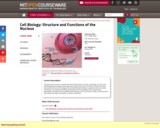
The goal of this course is to teach both the fundamentals of nuclear cell biology as well as the methodological and experimental approaches upon which they are based. Lectures and class discussions will cover the background and fundamental findings in a particular area of nuclear cell biology. The assigned readings will provide concrete examples of the experimental approaches and logic used to establish these findings. Some examples of topics include genome and systems biology, transcription, and gene expression.

The topic of this video module is how to classify animals based on how closely related they are. The main learning objective is that students will learn how to make phylogenetic trees based on both physical characteristics and on DNA sequence. Students will also learn why the objective and quantitative nature of DNA sequencing is preferable when it come to classifying animals based on how closely related they are. Knowledge prerequisites to this lesson include that students have some understanding of what DNA is and that they have a familiarity with the base-pairing rules and with writing a DNA sequence.
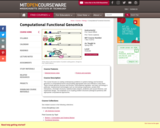
Study and discussion of computational approaches and algorithms for contemporary problems in functional genomics. Topics include DNA chip design, experimental data normalization, expression data representation standards, proteomics, gene clustering, self-organizing maps, Boolean networks, statistical graph models, Bayesian network models, continuous dynamic models, statistical metrics for model validation, model elaboration, experiment planning, and the computational complexity of functional genomics problems.

Students reinforce their knowledge that DNA is the genetic material for all living things by modeling it using toothpicks and gumdrops that represent the four biochemicals (adenine, thiamine, guanine, and cytosine) that pair with each other in a specific pattern, making a double helix. They investigate specific DNA sequences that code for certain physical characteristics such as eye and hair color. Student teams trade DNA "strands" and de-code the genetic sequences to determine the physical characteristics (phenotype) displayed by the strands (genotype) from other groups. Students extend their knowledge to learn about DNA fingerprinting and recognizing DNA alterations that may result in genetic disorders.

Students perform DNA forensics using food coloring to enhance their understanding of DNA fingerprinting, restriction enzymes, genotyping and DNA gel electrophoresis. They place small drops of different food coloring ("water-based paint") on strips of filter paper and then place one paper strip end in water. As water travels along the paper strips, students observe the pigments that compose the paint decompose into their color components. This is an example of the chromatography concept applied to DNA forensics, with the pigments in the paint that define the color being analogous to DNA fragments of different lengths.

As a class, students work through an example showing how DNA provides the "recipe" for making our body proteins. They see how the pattern of nucleotide bases (adenine, thymine, guanine, cytosine) forms the double helix ladder shape of DNA, and serves as the code for the steps required to make genes. They also learn some ways that engineers and scientists are applying their understanding of DNA in our world.

This online interactive module of 10 pages or frames integrates textual information, 3D molecular models, interactive molecular simulations, and embedded assessment items to guide students in understanding the copying of DNA base sequences from translation to transcription into proteins within each cell. The module divides the exercises in to Day 1 and Day 2 time frames. Teachers can view student assessment responses by assigning the module within a class created within the Molecular Workbench application. This Java-based module must be downloaded to each computer.
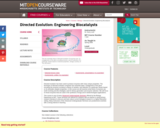
Enzymes, nature's catalysts, are remarkable biomolecules capable of extraordinary specificity and selectivity. Directed evolution has been used to produce enzymes with many unique properties, including altered substrate specificity, thermal stability, organic solvent resistance, and enantioselectivity--selectivity of one stereoisomer over another. The technique of directed evolution comprises two essential steps: mutagenesis of the gene encoding the enzyme to produce a library of variants, and selection of a particular variant based on its desirable catalytic properties. In this course we will examine what kinds of enzymes are worth evolving and the strategies used for library generation and enzyme selection. We will focus on those enzymes that are used in the synthesis of drugs and in biotechnological applications. This course is one of many Advanced Undergraduate Seminars offered by the Biology Department at MIT. These seminars are tailored for students with an interest in using primary research literature to discuss and learn about current biological research in a highly interactive setting. Many instructors of the Advanced Undergraduate Seminars are postdoctoral scientists with a strong interest in teaching.

In this video module, students learn how scientists use genetic information from dogs to find out which gene (out of all 20,000 dog genes) is associated with any specific trait or disease of interest. This method involves comparing hundreds of dogs with the trait to hundreds of dogs not displaying the trait, and examining which position on the dog DNA is correlated with the trait (i.e. has one DNA sequence in dogs with the trait but another DNA sequence in dogs not displaying the trait). Students will also learn something about the history of dog breeds and how this history helps us find genes.

After watching video clips from the Harry Potter and the Goblet of Fire movie, students explore the use of Punnett squares to predict genetic trait inheritance. The objective of this lesson is to articulate concepts related to genetics through direct immersive interaction based on the theme, The Science Behind Harry Potter. Students' interest is piqued by the use of popular culture in the classroom.
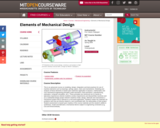
This is an advanced course on modeling, design, integration and best practices for use of machine elements such as bearings, springs, gears, cams and mechanisms. Modeling and analysis of these elements is based upon extensive application of physics, mathematics and core mechanical engineering principles (solid mechanics, fluid mechanics, manufacturing, estimation, computer simulation, etc.). These principles are reinforced via (1) hands-on laboratory experiences wherein students conduct experiments and disassemble machines and (2) a substantial design project wherein students model, design, fabricate and characterize a mechanical system that is relevant to a real world application. Students master the materials via problems sets that are directly related to, and coordinated with, the deliverables of their project. Student assessment is based upon mastery of the course materials and the student's ability to synthesize, model and fabricate a mechanical device subject to engineering constraints (e.g. cost and time/schedule).
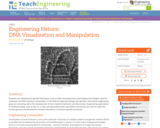
Students are introduced to genetic techniques such as DNA electrophoresis and imaging technologies used for molecular and DNA structure visualization. In the field of molecular biology and genetics, biomedical engineering plays an increasing role in the development of new medical treatments and discoveries. Engineering applications of nanotechnology such as lab-on-a-chip and deoxyribonucleic acid (DNA) microarrays are used to study the human genome and decode the complex interactions involved in genetic processes.

Under the "The Science Behind Harry Potter" theme, a succession of diverse complex scientific topics are presented to students through direct immersive interaction. Student interest is piqued by the incorporation of popular culture into the classroom via a series of interactive, hands-on Harry Potter/movie-themed lessons and activities. They learn about the basics of acid/base chemistry (invisible ink), genetics and trait prediction (parseltongue trait in families), and force and projectile motion (motion of the thrown remembrall). In each lesson and activity, students are also made aware of the engineering connections to these fields of scientific study.

This course is an introduction to computational biology emphasizing the fundamentals of nucleic acid and protein sequence and structural analysis; it also includes an introduction to the analysis of complex biological systems. Topics covered in the course include principles and methods used for sequence alignment, motif finding, structural modeling, structure prediction and network modeling, as well as currently emerging research areas.
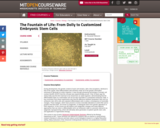
During development, the genetic content of each cell remains, with a few exceptions, identical to that of the zygote. Most differentiated cells therefore retain all of the genetic information necessary to generate an entire organism. It was through pioneering technology of somatic cell nuclear transfer (SCNT) that this concept was experimentally proven. Only 10 years ago the sheep Dolly was the first mammal to be cloned from an adult organism, demonstrating that the differentiated state of a mammalian cell can be fully reversible to a pluripotent embryonic state. A key conclusion from these experiments was that the difference between pluripotent cells such as embryonic stem (ES) cells and unipotent differentiated cells is solely a consequence of reversible changes. These changes, which have proved to involve reversible alterations to both DNA and to proteins that bind DNA, are known as epigenetic, to distinguish them from genetic alterations to DNA sequence. In this course we will explore such epigenetic changes and study different approaches that can return a differentiated cell to an embryonic state in a process referred to as epigenetic reprogramming, which will ultimately allow generation of patient-specific stem cells and application to regenerative therapy. This course is one of many Advanced Undergraduate Seminars offered by the Biology Department at MIT. These seminars are tailored for students with an interest in using primary research literature to discuss and learn about current biological research in a highly interactive setting. Many instructors of the Advanced Undergraduate Seminars are postdoctoral scientists with a strong interest in teaching.
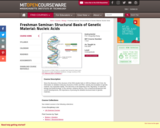
Since the discovery of the structure of the DNA double helix in 1953 by Watson and Crick, the information on detailed molecular structures of DNA and RNA, namely, the foundation of genetic material, has expanded rapidly. This discovery is the beginning of the "Big Bang" of molecular biology and biotechnology. In this seminar, students discuss, from a historical perspective and current developments, the importance of pursuing the detailed structural basis of genetic materials.
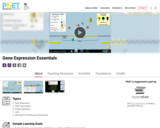
Express yourself through your genes! See if you can generate and collect three types of protein, then move on to explore the factors that affect protein synthesis in a cell.
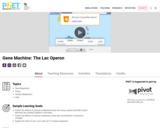
Build a gene network! The lac operon is a set of genes which are responsible for the metabolism of lactose in some bacterial cells. Explore the effects of mutations within the lac operon by adding or removing genes from the DNA.